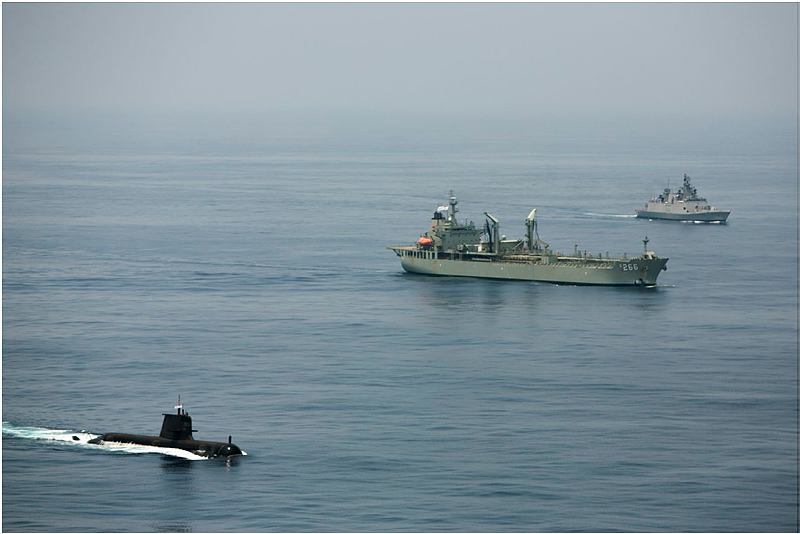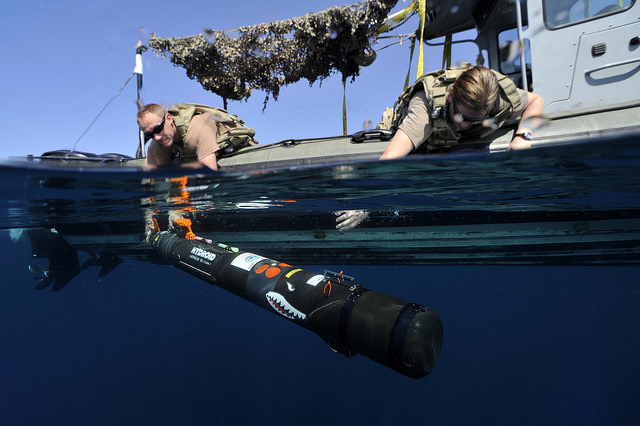Implementing Australia’s nuclear submarine program
Executive summary
On 16 September 2021, the Australian Government announced that it would acquire a nuclear-powered submarine (SSN) capability with support from the UK and the US as the first measure of business under the AUKUS technology sharing partnership. At the same time, it announced that it had established the Nuclear-Powered Submarine Taskforce, which would devote 18 months to determining the ‘optimal pathway’ to establishing this new capability.
The taskforce has its work cut out for it, and the signing of an initial nuclear information sharing agreement only two months after AUKUS was announced suggests things are moving fast. Nevertheless this new enterprise will be a massive undertaking and probably the largest and most complex endeavour Australia has embarked upon. The challenges, costs and risks will be enormous. It’s likely to be at least two decades and tens of billions of dollars in sunk costs before Australia has a useful nuclear-powered military capability.
Many commentators have suggested that the work of the taskforce is primarily about making a recommendation on the choice of submarine—either the US Virginia class or the UK Astute class. That’s misleading on two counts. First, the most important decision isn’t so much about the submarine, but about the strategic partner most able to work with us on our new SSN capability. Second, Australia will need to make many choices—about the strategic partner, about the submarine design, about the build strategy, about schedule, and more. Those choices will involve hard prioritisation decisions about what’s most important. Is it capability, schedule, Australian industry content, or something else?
This report examines the decision space available to the government.
The most important decision is the choice of our primary strategic partner. While both the US and the UK will need to provide us with assistance regardless of which submarine design we choose, there’s no point picking a boat if its parent nation doesn’t have the capacity to assist us with all of the fundamental inputs to capability needed to deliver military effects, or its industrial base doesn’t have the capacity to deliver. While we shouldn’t pre-empt the work of the taskforce, initial analysis suggests that the US has more capacity to assist us.
Even once we choose a partner, we still have some difficult choices about the submarine design. Do we prioritise schedule and build our partner’s current design, with the result that we’re left with an orphaned and outdated fleet? Do we wait to get into step with our partner’s next class, exacerbating the risk of a capability gap? Or do we start with the current design and transition later to the partner’s future design, with the result that we have multiple classes of boat in our small fleet?
Another area of choice is the amount of modification we do to the design. While some modifications will be necessary due to Australia’s regulatory and safety regimes—unless we recognise our partner’s regulatory approaches as fit for purpose and accommodate ours to theirs—others will be discretionary. Every effort must be made to limit the changes, whether they’re motivated by capability or Australian industry content, as every change drives cost and schedule risk regardless of how well intentioned it is.
A fundamental choice is the build strategy. The government has stated that the SSNs will be built in Adelaide; however, it hasn’t committed to a continuous build. A continuous-build approach (one driven by a schedule designed to replace the first boat after around 30 years with no break in production) is appealing to Australian industry and current and future workers but would face many challenges—boats would be delivered on an inefficient three- or even four-year drumbeat, driving up cost and increasing the capability gap. Alternatively, an ‘economic’ approach that focused on the most efficient possible approach would deliver capability faster but require massive annual spending and produce the prospect of a ‘valley of death’ at the end of production. Either approach replicates a nuclear-submarine production capability in Australia as our own sovereign cottage-industry version of what the UK and the US already have.
Underpinning all of those choices is the issue of schedule. We’re facing the looming spectre of a submarine capability gap as the Collins-class fleet ages out. The government’s stated schedule, delivering at least the first boat by the late 2030s, is feasible, if optimistic, if we build all the boats in Australia. But that may be too late to avoid a capability gap.
An alternative that could accelerate delivery would be to open up the aperture of what ‘built in Adelaide’ should look like. One approach we consider is to build the initial boats overseas to accelerate delivery but also to train Australian workers on a mature production line to avoid a ‘cold start’ to local production.
But there are also options that approach this enterprise as the embodiment of our AUKUS and alliance partnerships rather than as a large, but traditional, construction project. This could involve a ‘JSF’ (Joint Strike Fighter) approach of feeding components into a joint submarine enterprise that Australia enters with our primary enterprise partner. Such a joint enterprise would span more than just construction and enable Australia to be a ‘first line’ sustainment hub for our AUKUS partners’ submarines as well as for our own. When we consider that just the maintenance of Australia’s SSNs will be likely to require more workforce than the Attack-class build and Collins-class full-cycle dockings combined, there are ways to deliver submarines faster, sustain sovereign capability, contribute to our partnerships and still create jobs that don’t involve assembling submarines here.
And this can’t be stated clearly or often enough: successful transition isn’t just about delivering boats but all of the elements of the capability. So, the choice of boat and build approaches aren’t just matters of capability or industry but must be informed by broader inputs to capability. Perhaps the most important of those is the challenge of how the Navy ramps up its uniformed workforce; solving that problem is just as crucial as delivering boats on time. Again, AUKUS has much to offer here.
Finally, we’ve provided an estimate of the cost of the enterprise. Such an exercise is inherently hazardous at this stage of the process, with so many assumptions still open and untested. The government has been open in stating that the SSN program will cost more than the Attack-class program, which would have cost around $56–57 billion in current-day constant dollars.
We agree: at an absolute minimum, an eight-boat SSN program will cost around $70 billion constant (or $116 billion in out-turned dollars, which account for inflation).
However, it’s highly likely that it will cost substantially more once the cost drivers are more clearly understood. Those include both the US and UK moving to bigger submarine designs, our choice of build strategy, and the broader support system and infrastructure needed to operate nuclear submarines. To channel Donald Rumsfeld, there are things we know we don’t know, and things we don’t know we don’t know; both will drive up the estimate.
Introduction
On 16 September 2021, the Australian Government announced that it would acquire a nuclear-powered submarine (SSN) capability with support from the UK and the US as the first measure under the AUKUS technology sharing partnership. This will be a massive undertaking and probably the largest and most complex endeavour Australia has embarked upon. The challenges, costs and risks will be enormous. It’s likely that it will be at least two decades before Australia has any useful SSN capability if we follow a traditional acquisition approach.
In order to chart this long, difficult journey, the government also announced the establishment of the Nuclear-Powered Submarine Taskforce to make recommendations on the optimal path. The signing of an initial nuclear information sharing agreement between the partners only two months after AUKUS was announced suggests that the taskforce is moving fast and all three partners are open to new approaches. Nevertheless, the taskforce has a mammoth task ahead of it.
This paper explores the issues that the taskforce will need to address in order to set Australia on the path to success. While the broader AUKUS announcement and the decision’s impact on Australia’s relationship with France are both significant issues, they’re beyond the scope of this paper, which is presented in the following parts.
Before embarking on such a long and expensive journey that presents a massive opportunity cost, it’s important to confirm whether it’s the right capability to pursue in the first place. Chapter 1 looks at the advantages of nuclear submarines over conventional submarines. Ultimately, they come down to the SSN’s essentially infinite supply of energy.
Chapter 2 examines the two core decisions for the government: its primary strategic partner, including the partner’s commercial team, and the submarine. Those choices are of course deeply interdependent, but it’s crucial to remember that the task is much broader than choosing a submarine; there’s no point picking a suitable submarine if we don’t have a partner who can help us design, build, operate and sustain the boats and develop all the other elements needed to produce an effective military capability.
Many factors are interrelated here. Some decisions will be determined by previous ones and, in turn, shape later ones. Overall, we attempt to sketch out the decision space available to the government and the trade-offs involved in choosing a particular solution.
In Chapter 3, we examine the construction strategy. The government has stated that it’s ‘committed to maximising Australian industry participation in this program’. What’s the best way to do that? And does that automatically mean signing up to a ‘continuous-build’ approach that drags out delivery and decreases efficiency? Or even a traditional ‘local-build’ approach? We look at four possible approaches.
In Chapter 4, we look beyond the submarine to consider the broad range of ‘fundamental inputs to capability’ needed to deliver an effective military capability. The taskforce will need to develop a solid understanding of those requirements, not just because the submarines will be ineffective without them, but because different requirements for different submarine designs (such as workforce, infrastructure and training) could be key discriminators in the selection of the boat itself. Those fundamental inputs will also be major cost drivers and need to be identified in order to fully understand the cost of this undertaking.
In Chapter 5, we briefly look at the schedule for the program. The government has already indicated that it’s likely to be the late 2030s at the earliest before we have any operationally useful SSN capability. Almost immediately, commentators proposed approaches that they believed would deliver capability sooner. The taskforce has also indicated that it’s looking at ways to bring the introduction of capability forward. In this chapter, we both examine what the schedule looks like if Australia does things ‘by the book’ as a more or less traditional Australian-based procurement and construction program and consider what options there might be to accelerate the schedule by doing things differently.
In Chapter 6, we look at the cost involved in acquiring an SSN capability. Since cost estimation is highly assumption dependent and many key assumptions are still open, it’s impossible to develop a reliable point estimate. Moreover, the full overhead of operating the capability in terms of training, safety and regulatory structures is yet to be defined. It’s possible, however, to make a broad (but admittedly incomplete) estimate of the cost based on some key variables, such as the size of the submarine and the build strategy. Therefore, we provide a cost band to cover the substantial uncertainties in the program. The government has already said that the SSN program will cost more than the cancelled Attack-class program would have; depending on the assumptions, it could cost substantially more.
Read the full report
We warmly invite you to download and read the full report, which can be found here.
Author discussion
Michael Shoebridge discussed the report with authors Andrew Nicholls and Dr Marcus Hellyer.
Acknowledgement
The authors would like to thank Michael Shoebridge, director of ASPI’s defence, strategy and national security program, for his insightful comments on drafts of this report.
About ASPI
The Australian Strategic Policy Institute was formed in 2001 as an independent, non‑partisan think tank. Its core aim is to provide the Australian Government with fresh
ideas on Australia’s defence, security and strategic policy choices. ASPI is responsible for informing the public on a range of strategic issues, generating new thinking for
government and harnessing strategic thinking internationally. ASPI’s sources of funding are identified in our Annual Report, online at www.aspi.org.au and in the
acknowledgements section of individual publications. ASPI remains independent in the content of the research and in all editorial judgements. It is incorporated as a
company, and is governed by a Council with broad membership. ASPI’s core values are collegiality, originality & innovation, quality & excellence and independence.
ASPI’s publications—including this paper—are not intended in any way to express or reflect the views of the Australian Government. The opinions and recommendations
in this paper are published by ASPI to promote public debate and understanding of strategic and defence issues. They reflect the personal views of the author(s) and should not be seen as representing the formal position of ASPI on any particular issue.
Important disclaimer
This publication is designed to provide accurate and authoritative information in relation to the subject matter covered. It is provided with the understanding that the
publisher is not engaged in rendering any form of professional or other advice or services. No person should rely on the contents of this publication without first obtaining advice from a qualified professional.
© The Australian Strategic Policy Institute Limited 2021
This publication is subject to copyright. Except as permitted under the Copyright Act 1968, no part of it may in any form or by any means (electronic, mechanical, microcopying, photocopying, recording or otherwise) be reproduced, stored in a retrieval system or transmitted without prior written permission. Enquiries should be addressed to the publishers.
Notwithstanding the above, educational institutions (including schools, independent colleges, universities and TAFEs) are granted permission to make copies of copyrighted works strictly for educational purposes without explicit permission from ASPI and free of charge.
First published December 2021
Published in Australia by the Australian Strategic Policy Institute
Funding Statement:
No specific sponsorship was received to fund production of this report.











